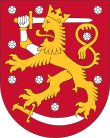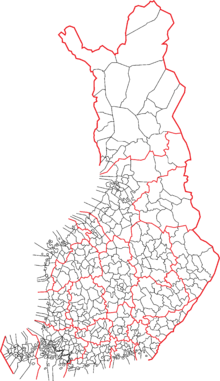You can help expand this article with text translated from the corresponding article in Finnish. (June 2023) Click for important translation instructions.
|
| Part of a series on |
| Administrative divisions of Finland |
|---|
| Regions |
| Sub-regions |
| Municipalities |
| Wellbeing services counties |
| Politics of Finland |
|---|
 |
| State |
Executive
|
| Legislative |
| Judiciary |
| Recent elections |
| Political parties |
Administrative divisions
|
Foreign relations
|
Finland is divided into:
- 19 regions (Finnish: maakunta, Swedish: landskap)
- the regions are divided into 70 sub-regions (Finnish: seutukunta, Swedish: ekonomisk region)
- the sub-regions are divided into 309 municipalities (Finnish: kunta, Swedish: kommun).
Furthermore, health, social and emergency services are responsible of 21 Wellbeing services counties (Finnish: hyvinvointialue, Swedish: välfärdsområde).
Description

Black borders refer to municipalities, red to regions.
Municipalities (which may also call themselves towns or cities) account for half of public spending. Spending is financed by municipal income tax, state subsidies, and other revenue. As of 2017, there are 311 municipalities, and most were under 5,000 residents. In Finland, state has started the Municipality and Service Structure Reform Program to reform the complex and expensive municipal system, but initiatives have encountered much opposition from local bureaucrats and interest groups. People often identify with their municipality. Government's local administrative duties are performed by the Regional State Administrative Agencies.
In addition to municipalities, there are complex other arrangements. Municipalities co-operate in seventy-four sub-regions and twenty regions. These are governed by the member municipalities. The Åland region has a permanent, democratically elected regional council, as a part of the autonomy. Sami people have a semi-autonomous Sami Domicile Area in Lapland for issues on language and culture.
Wellbeing services counties are responsible for organising health, social and emergency services. There are 21 counties for wellbeing services, and the structure of the counties is mainly based on the structure of the regions. Wellbeing services districts are self-governing. However, they do not have the right to levy taxes. Their funding is based on central government funding. Depending on their population structure, central government allocates different amounts of funding to different Wellbeing Services Counties.
The County Council is responsible for operations, administration and finance and is the highest decision-making body in the county. The delegates and the deputy commissioners of the County Council are elected in the county elections for a term of office of four years. The number of delegates varies between 59 and 89. The number depends on the number of inhabitants in the county.
See also
- List of municipalities of Finland
- List of former municipalities of Finland
- Subdivisions of the Nordic countries
References
- "Regions and municipalities". Suomi.fi. 2016-01-01. Retrieved 2016-04-29.
- "Tilastokeskus - Luokitukset - Sub-regional units 2013". Tilastokeskus.fi. Archived from the original on 26 December 2019. Retrieved 24 December 2017.
- "Suomen virallinen tilasto (SVT): Väestön ennakkotilasto [verkkojulkaisu]. Joulukuu 2020" (in Finnish). Statistics Finland. Archived from the original on 26 June 2019. Retrieved 11 February 2021.
- ^ "Wellbeing services counties will be responsible for organising health, social and rescue services on 1 January 2023". Ministry of Social Affairs and Health. Retrieved 7 September 2023.
| Finland articles | |||||
|---|---|---|---|---|---|
| History | |||||
| Geography | |||||
| Politics | |||||
| Economy | |||||
| Society |
| ||||
| Administrative divisions of Europe | |
|---|---|
| Sovereign states |
|
| States with limited recognition | |
| Dependencies and other entities | |